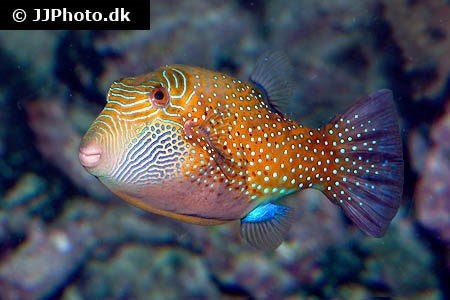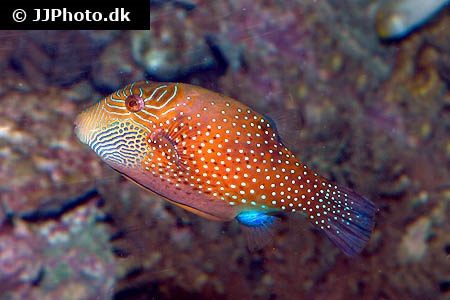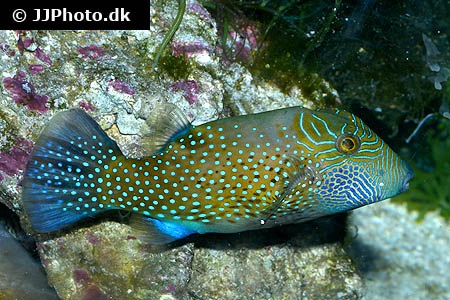Canthigaster amboinensis
| Latin name | Canthigaster amboinensis - (Bleeker, 1864) |
|---|---|
| Local name | Spider-eye puffer |
| Family | Tetraodontidae - Canthigaster |
| Origin | East Indian Ocean, West Indian Ocean, Australia, Japan, Indonesia, East Pacific, Central/West Pacific |
| Max length | 15 cm (5.9") |
| Minimum volume |
500 l (132 gal) |
|---|---|
| Hardiness |
Average |
| Suitable for aquarium |
Suitable with care |
| Reef safe |
Not reef safe |
| Aggressiveness | Mostly peaceful but might be aggressive towards similar species of same gender |
| Recommended |
Macroalgea (Eg. seaweed / nori) Microalgea (Eg. spirulina) Small crustaceans (Krill, mysis, artemia...) |
|---|---|
| Mostly |
Larger crustaceans (Shrimp, crabs...) Other invertebrates Soft coral |
| Maybee |
Large polyp stone coral (LPS) |
This species eats shrimps, crayfish, crabs, small bivalves, sea urchins, snails and similar.
There is little available knowledge of this species, so there can be important information missing on this page.
This species has a vulnerable skin, take extra care when catching or transporting, so the skin doesn´t get damaged.
These fish must not suck in air when they are being fed or transported, as they have difficulties expelling it again.
This species has a toxin in its skin, which it releases when highly stressed or dying.
This poison can kill all the aquatic life in the aquarium, if unlucky.
These fish require food which helps to prevent overgrowing teeth. e.g. clams.
If their teeth grow too much, it might necessitate grinding them down, however this is a very stressful procedure.
These fish should be kept in a well run aquarium where they can "graze" algae from rocks and stones.
If there are insufficient algae on the rocks, it is important to feed more frequently and supplement with algae rich food e.g. Spirulina.
This species can live as a pair (male and female).
This species often has a fun and interesting personality.
Fish from the Canthigaster genus, also known as Tobies, are smaller then most pufferfish and cannot blow themselves up to the same degree.
Some, but by no means all, are known nip other fish, hermit crabs and the like. These small Pufferfish can sometimes be kept in a coral aquarium, but it is necessary to ascertain which corals they are likely to nip.
Pufferfish (Tetraodontidae) are known for their unique way of swimming, their very interesting personality and of course their ability to puff up. It is not a coincidence that so many aquarists fall for these funny fish.
In nature, pufferfish blow water onto sand to find food, hence they are also called "Blowfish". They will sometimes do this in the aquarium. In addition to this they will also spray water out of the tank, so do not be suprised if they do :-)
Site electrical equipment with care.
Many of the species have spines, but these can normally only be seen when the fish is puffed up.
They are not generally reef safe, and will sometimes nibble at the fins of the other fish. They are, on the other hand, very hardy and if ones purchases a healthy specimen it can live for many years under good conditions.
One must be careful when handling and transporting the fish, as many of the species will release a toxin into the water.
They are described as being difficult to keep, but if one has the correct equipment and food, it is indeed possible. Something to be aware of with Pufferfish is that they demand a lot of food, so the aquarium must be able to handle this. They require food which grinds their teeth, as they keep on growing through out their life. The fish is unable to eat if their teeth grow too long. Suitable foods are snails or mussels.
Flake foods are not suitable for pufferfish even though they will eat it. It must be supplemented with a varied selection of seafood and frozen foods.
When selecting a pufferfish at the fish store, one must be aware of parasites, as these are quite common among them. These may show up as white spots or small irregularities in the skin. They can also have internal parasites which can only be avoided by quarantining the fish.
See more about feeding, selecting and diseases in John Champlin's article.
| Aquarium trade | Yes |
|---|---|
| Distribution | Indo-Pacific: East Africa to the Galapagos Islands, north to southern Japan and Hawaii, south to the Great Barrier Reef and the Society Islands. |
| English common names |
Spider-eye puffer Ambon toby Ambon pufferfish |
Scott Michael. Aquarium Fish: The Papuan (Canthigaster papua) and Ocellated Toby (C. solandri) - Advanced Aquarist - (English)
John Champlin. Puffer Care and Information - Reefnut.com (web.archive.org) - (English)
Bob Fenner. All My Puffers, Tobies, Box, Porcupine, Cowfishes - Wet Web Media - (English)





